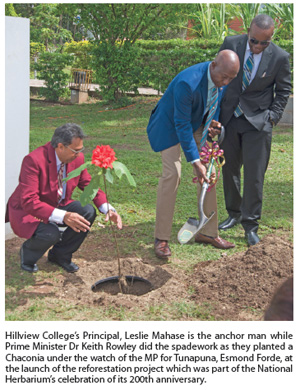|
August 2018

Issue Home >>
|
 
The term ‘Urban Greening’ embraces activities such as public landscaping and the creation of urban forestry that seek to ‘green’ and soften the urban landscape and make it, as they say, more ‘people friendly’. These greening initiatives include planting road verges and islands with indigenous vegetation, removal of alien species, upgrading of parks and gardens in inner city areas, development of urban trails passing through green areas, and getting landscape architects to design or redesign inner city areas to reflect a more natural and green surrounding.
Urban greening provides one other, perhaps more important benefit than just ‘softening’ the urban character of our surroundings. Its ecological impact offsets the deleterious effect of urbanisation and industrialisation on the environment and on human health. I have often made the point that every building that is erected potentially increases the level of flooding in lower areas, unless adequate provision is made to handle water runoff.
The more our country turns into a concrete jungle, the worse it becomes. In contrast, trees extract water from the ground and help control water saturation and flooding. Greening is considered as one approach to mitigate the human health consequences of increased temperatures that result from climate change.
And that’s not all. Researchers at Columbia University have found a high correlation between the increase in tree population in urban neighbourhoods and a lower incidence of asthma. Just consider how miserable life recently has been for many of us due to the Saharan dust. Trees capture airborne particles such as dirt, dust and soot. As students of biology would know, they clean the air by absorbing greenhouse gases that contribute to global warming, storing carbon dioxide, the primary greenhouse gas, in their stems and leaves. Indeed, I am told that two medium-sized, healthy trees can supply the oxygen required for a single person for a year.
In May 2017, Trinidad and Tobago registered its first “green” building when a flagship commercial development was opened in Port of Spain. The building, Savannah East, was designed and built in an environmentally responsible manner and promotes recycling, encourages sustainable energy through the use of rainwater to flush fixtures, condensate water from the air-conditioning system to irrigate the green spaces in the building, insulated windows and roofing to reduce heat transfer, and the creation of energy every time the elevator is used. Our architects, contractors, and planning officials should encourage this approach!
 Research has also uncovered some unexpected benefits of urban greening. Three scientists in the US: Jody Rosenblatt Naderi, Byoung-Suk Kweon and Praveen Maghelal, presented empirical findings from a pilot study on street trees and their effect on driving behaviour, safety perception and speed in urban or suburban areas. They surmised that tree-lined streets are safer in both urban and suburban areas. In addition, individual driving speeds were significantly lower in the suburban settings with trees. In other words, trees calm traffic and reduce the frequency and severity of crashes. This research suggests that, quite apart from the aesthetic appeal, there is validity – from a safety perspective – in having trees on our streets and highways. You may recall there was a bit of an outcry when the trees lining the median of the highway between Curepe and Valsayn, were removed. I am therefore pleased to note that Works and Transport Minister, Rohan Sinanan, has promised that trees will be replanted once the new interchange is completed. Research has also uncovered some unexpected benefits of urban greening. Three scientists in the US: Jody Rosenblatt Naderi, Byoung-Suk Kweon and Praveen Maghelal, presented empirical findings from a pilot study on street trees and their effect on driving behaviour, safety perception and speed in urban or suburban areas. They surmised that tree-lined streets are safer in both urban and suburban areas. In addition, individual driving speeds were significantly lower in the suburban settings with trees. In other words, trees calm traffic and reduce the frequency and severity of crashes. This research suggests that, quite apart from the aesthetic appeal, there is validity – from a safety perspective – in having trees on our streets and highways. You may recall there was a bit of an outcry when the trees lining the median of the highway between Curepe and Valsayn, were removed. I am therefore pleased to note that Works and Transport Minister, Rohan Sinanan, has promised that trees will be replanted once the new interchange is completed.
At The UWI, we do recognize the fact that in all possible future scenarios, including even any description of a worst-case scenario, we have to take care of the environment in which we live.
This is the gist of what I said at the launch of a reforestation project, where we joined with Hillview College, the Forestry Division, and the UWI Biological Society as the National Herbarium marked its 200th anniversary by planting 200 trees on the denuded hillside to the north of the College.
It was a small start to building that sustainably developed future but it was a start, nonetheless and an example that I hope other schools across Trinidad and Tobago will follow. We were delighted to have Prime Minister Dr. Keith Rowley join us, as he has also encouraged the planting of our national flower, the Double Chaconia, in schools nationwide.
Bringing an appreciation of greenery in our urban landscapes is one way we can secure a sustainable ecological future. We all have to act, to do something one way or the other, to ensure that this future will exist. There is no better time to plant that tree than now.
Professor Brian Copeland
Pro Vice-Chancellor and Principal
EDITORIAL TEAM
Campus Principal: Professor Brian Copeland
Director of Marketing and Communications: Dr. Dawn-Marie De
Four-Gill
Editor: Vaneisa Baksh (Email: vaneisa.baksh@sta.uwi.edu )
Contact us:
The UWI Marketing and Communications Office
Tel: (868) 662-2002 exts. 82013, 83997
Email: uwitoday@sta.uwi.edu
|





